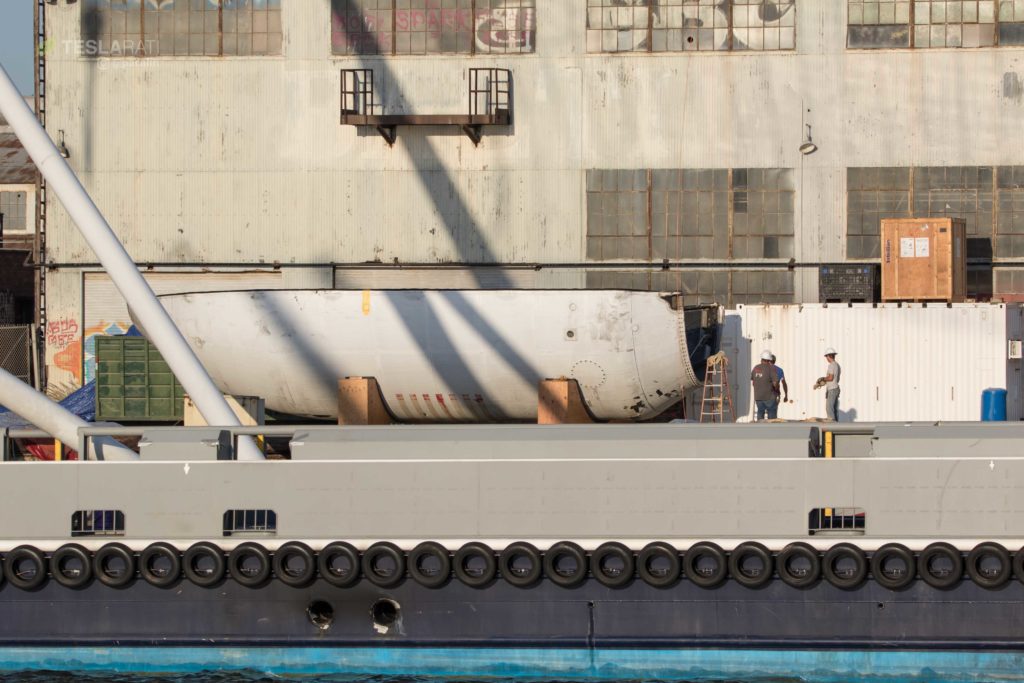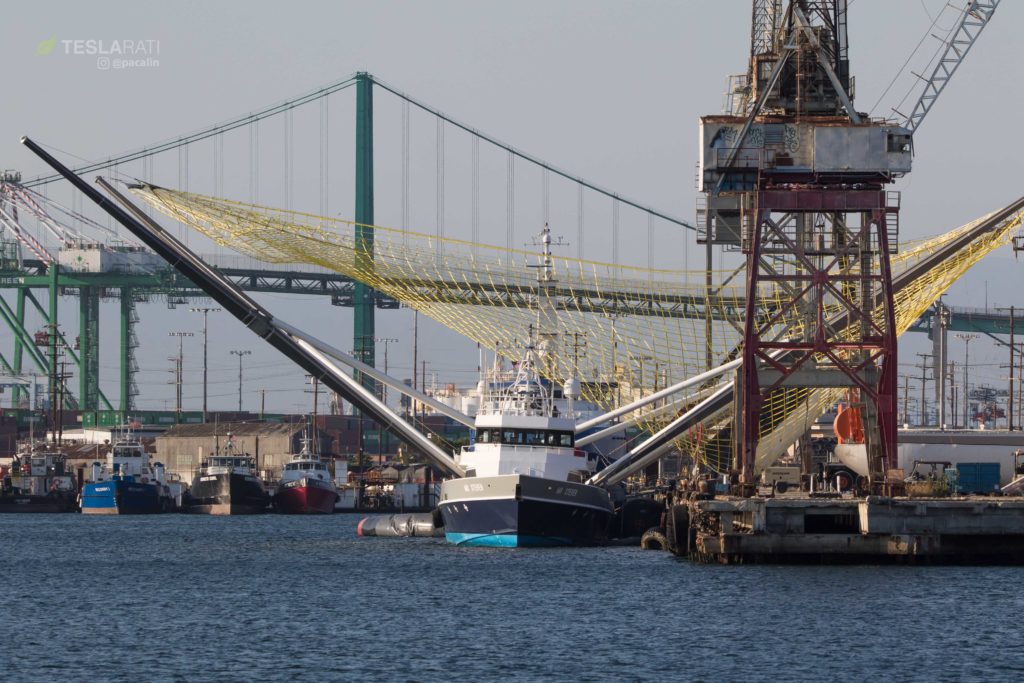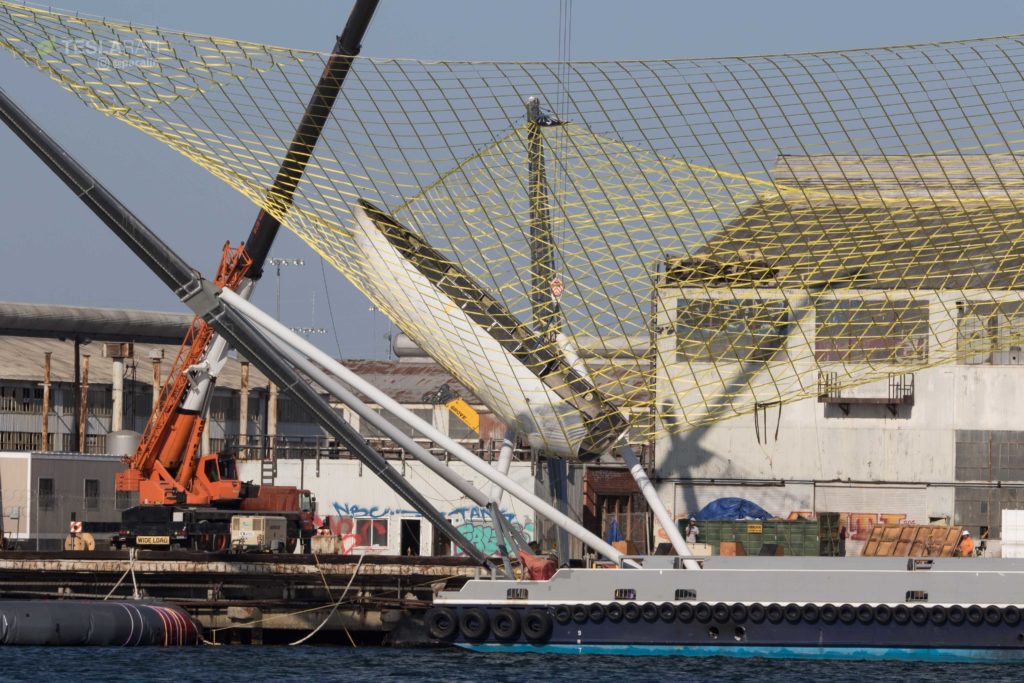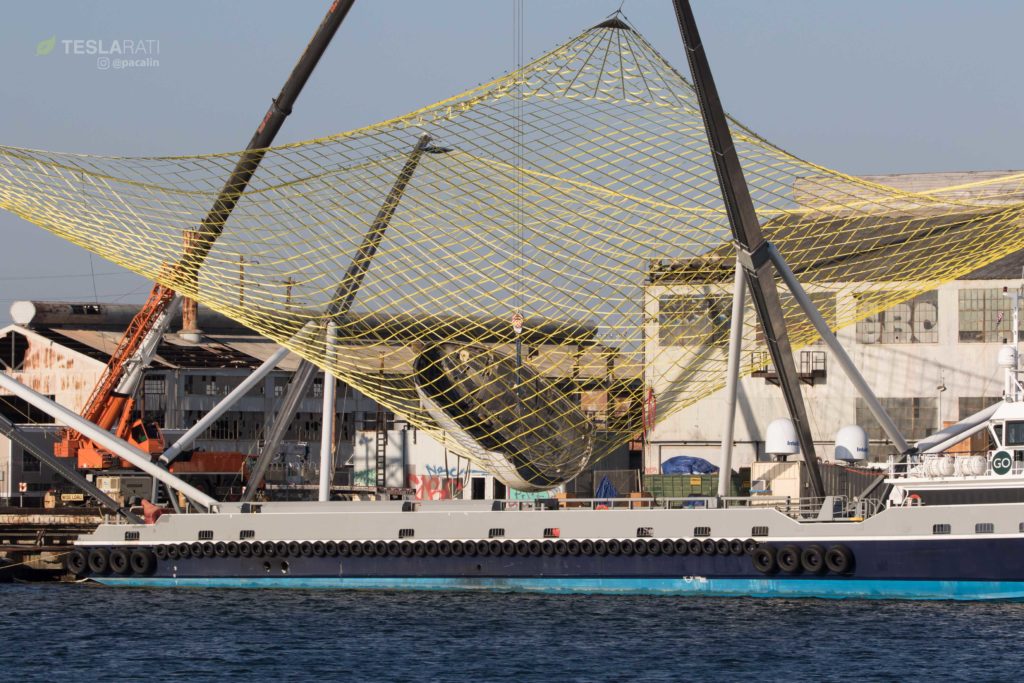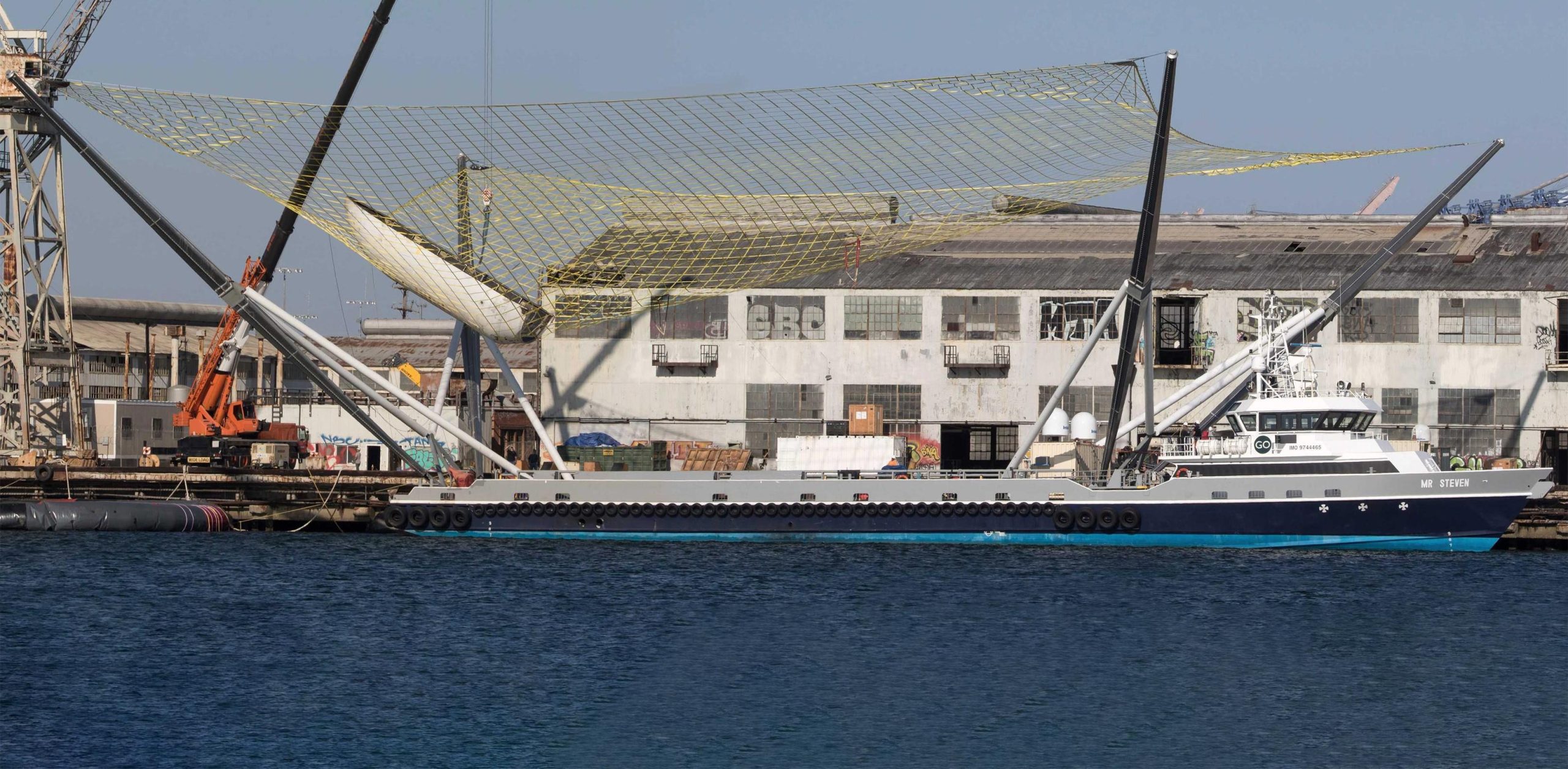
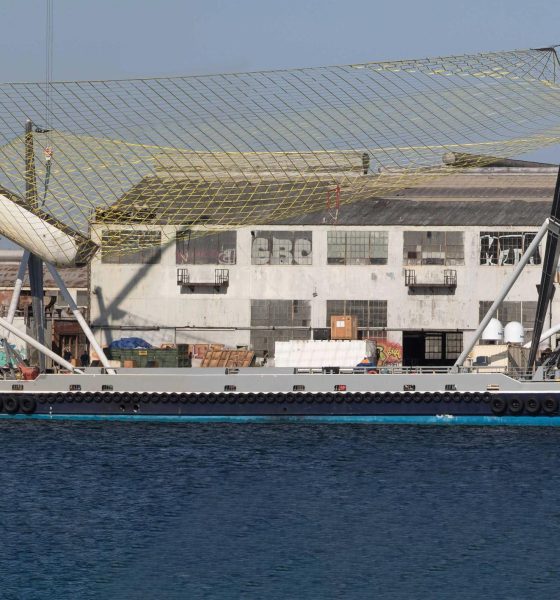
News
SpaceX’s Mr Steven spotted practicing Falcon 9 fairing catches with upgraded net
SpaceX’s fairing recovery vessel Mr Steven was spotted on Monday, August 13 conducting the first fairing recovery tests to involve actually craning a fairing half onto the huge, upgraded net, and doing so repeatedly in a short period of time. That practice will likely prove invaluable by allowing SpaceX to better understand the characteristics of Mr Steven’s fairing-catching net, rigging winches, and general operational behavior.
As SpaceX gradually approaches their next Falcon 9 launch from Vandenberg Air Force Base, the company is also preparing for Mr Steven’s next fairing recovery attempt, itself the second operational use of the vessel’s massively upgraded arms and net. Known as SAOCOM-1A, the Argentinian space agency’s Earth-imaging satellite is expected to launch no earlier than late September according to local South American media. Mr Steven’s late-July upgraded net debut was largely foiled by unpredictable winds in the region the fairing was parasailing, with that uncertainty preventing the fairing from getting close enough to its targeted landing position for Mr Steven to catch it out of the air.
It certainly appears that Mr Steven's net is capable of receiving a fairing half. Getting closer than ever. 8/13 #spaceX #mrsteven pic.twitter.com/Zqydum2FbB
— Pauline Acalin (@w00ki33) August 14, 2018
By all appearances, SpaceX is working hard to better understand how Mr Steven’s huge new net behaves when interacting with a Falcon fairing half, a reasonable goal in order to ensure that the first successful fairing catch is not foiled by something as simple as the half sliding down the net and cracking on Mr Steven’s deck. SpaceX’s fairings are incredibly fragile and are liable to irreparable crack at the slightest hint of off-nominal forces, meaning that all recovery efforts need to be extremely gentle if SpaceX ever hopes to recover and reuse those fairings halves multiples times, if at all.
- SpaceX technicians convene while testing Mr Steven’s net with a Falcon fairing half, 08/13/18. (Pauline Acalin)
- SpaceX used a crane to test Mr Steven’s net with a Falcon fairing half, 08/13/18. (Pauline Acalin)
- Mr Steven’s net spied testing off-center recovery operations with a Falcon fairing half, 08/13/18. (Pauline Acalin)
- Mr Steven’s net spied testing off-center recovery operations with a Falcon fairing half, 08/13/18. (Pauline Acalin)
- Mr Steven’s net spied testing off-center recovery operations with a Falcon fairing half, 08/13/18. (Pauline Acalin)
Still, even managing to reuse just one fairing half once for several launches (say, all California launches) would make a huge difference to the bottlenecked production line in SpaceX’s Hawthorne rocket and spacecraft factory, which is working around the clock to ramp up production of the upgraded Fairing 2.0 while also winding down the old Fairing 1.0 manufacturing apparatus. Intriguingly, it appears that SpaceX’s launch activity is likely to drop precipitously over the next several months, with no launches currently scheduled from the company’s two Florida pads in September or October – apparently due to a lack of payload availability rather than anything SpaceX-related.
Vandenberg will thus be the focus of SpaceX’s launch activities in September and October, hopefully supporting at least two missions. The first, SAOCOM-1A, is an Argentinian Earth observation satellite targeting a launch window in late September, reportedly delayed from September 5 to give SpaceX additional time to prepare Falcon 9. According to NASASpaceflight.com, SpaceX intends to refly Falcon 9 B1048 for this mission, giving the company just 6-8 weeks to refurbish the rocket and prepare it for the usual preflight static fire several days before launch. SAOCOM-1A will also likely mark the debut of SpaceX’s West Coast rocket landing zone, known as LZ-2.
Mr Steven lowering a fairing half into and out of the net today! Practice makes perfect.#spacex #mrsteven pic.twitter.com/oo4YAyWcuK
— Pauline Acalin (@w00ki33) August 14, 2018
While not yet solid, Iridium CEO Matt Desch acknowledged on August 13th that the company’s 8th and final SpaceX launch – Iridium NEXT-8 – would have its satellites ready no earlier than October, likely making it SpaceX’s subsequent payload after SAOCOM-1A. On the opposite coast, SpaceX’s next launch will be Telstar 18V – companion to 19V – on a new Falcon 9 Block 5 booster, currently scheduled for no earlier than 11:33 PM EDT, August 23. That Falcon 9 is already at Pad 40 preparing for a preflight static fire late this week or early next.
For prompt updates, on-the-ground perspectives, and unique glimpses of SpaceX’s rocket recovery fleet check out our brand new LaunchPad and LandingZone newsletters!

News
Tesla is not sparing any expense in ensuring the Cybercab is safe
Images shared by the longtime watcher showed 16 Cybercab prototypes parked near Giga Texas’ dedicated crash test facility.

The Tesla Cybercab could very well be the safest taxi on the road when it is released and deployed for public use. This was, at least, hinted at by the intensive safety tests that Tesla seems to be putting the autonomous two-seater through at its Giga Texas crash test facility.
Intensive crash tests
As per recent images from longtime Giga Texas watcher and drone operator Joe Tegtmeyer, Tesla seems to be very busy crash testing Cybercab units. Images shared by the longtime watcher showed 16 Cybercab prototypes parked near Giga Texas’ dedicated crash test facility just before the holidays.
Tegtmeyer’s aerial photos showed the prototypes clustered outside the factory’s testing building. Some uncovered Cybercabs showed notable damage and one even had its airbags engaged. With Cybercab production expected to start in about 130 days, it appears that Tesla is very busy ensuring that its autonomous two-seater ends up becoming the safest taxi on public roads.
Prioritizing safety
With no human driver controls, the Cybercab demands exceptional active and passive safety systems to protect occupants in any scenario. Considering Tesla’s reputation, it is then understandable that the company seems to be sparing no expense in ensuring that the Cybercab is as safe as possible.
Tesla’s focus on safety was recently highlighted when the Cybertruck achieved a Top Safety Pick+ rating from the Insurance Institute for Highway Safety (IIHS). This was a notable victory for the Cybertruck as critics have long claimed that the vehicle will be one of, if not the, most unsafe truck on the road due to its appearance. The vehicle’s Top Safety Pick+ rating, if any, simply proved that Tesla never neglects to make its cars as safe as possible, and that definitely includes the Cybercab.
Elon Musk
Tesla’s Elon Musk gives timeframe for FSD’s release in UAE
Provided that Musk’s timeframe proves accurate, FSD would be able to start saturating the Middle East, starting with the UAE, next year.

Tesla CEO Elon Musk stated on Monday that Full Self-Driving (Supervised) could launch in the United Arab Emirates (UAE) as soon as January 2026.
Provided that Musk’s timeframe proves accurate, FSD would be able to start saturating the Middle East, starting with the UAE, next year.
Musk’s estimate
In a post on X, UAE-based political analyst Ahmed Sharif Al Amiri asked Musk when FSD would arrive in the country, quoting an earlier post where the CEO encouraged users to try out FSD for themselves. Musk responded directly to the analyst’s inquiry.
“Hopefully, next month,” Musk wrote. The exchange attracted a lot of attention, with numerous X users sharing their excitement at the idea of FSD being brought to a new country. FSD (Supervised), after all, would likely allow hands-off highway driving, urban navigation, and parking under driver oversight in traffic-heavy cities such as Dubai and Abu Dhabi.
Musk’s comments about FSD’s arrival in the UAE were posted following his visit to the Middle Eastern country. Over the weekend, images were shared online of Musk meeting with UAE Defense Minister, Deputy Prime Minister, and Dubai Crown Prince HH Sheikh Hamdan bin Mohammed. Musk also posted a supportive message about the country, posting “UAE rocks!” on X.
FSD recognition
FSD has been getting quite a lot of support from foreign media outlets. FSD (Supervised) earned high marks from Germany’s largest car magazine, Auto Bild, during a test in Berlin’s challenging urban environment. The demonstration highlighted the system’s ability to handle dense traffic, construction sites, pedestrian crossings, and narrow streets with smooth, confident decision-making.
Journalist Robin Hornig was particularly struck by FSD’s superior perception and tireless attention, stating: “Tesla FSD Supervised sees more than I do. It doesn’t get distracted and never gets tired. I like to think I’m a good driver, but I can’t match this system’s all-around vision. It’s at its best when both work together: my experience and the Tesla’s constant attention.” Only one intervention was needed when the system misread a route, showcasing its maturity while relying on vision-only sensors and over-the-air learning.
News
Tesla quietly flexes FSD’s reliability amid Waymo blackout in San Francisco
“Tesla Robotaxis were unaffected by the SF power outage,” Musk wrote in his post.

Tesla highlighted its Full Self-Driving (Supervised) system’s robustness this week by sharing dashcam footage of a vehicle in FSD navigating pitch-black San Francisco streets during the city’s widespread power outage.
While Waymo’s robotaxis stalled and caused traffic jams, Tesla’s vision-only approach kept operating seamlessly without remote intervention. Elon Musk amplified the clip, highlighting the contrast between the two systems.
Tesla FSD handles total darkness
The @Tesla_AI account posted a video from a Model Y operating on FSD during San Francisco’s blackout. As could be seen in the video, streetlights, traffic signals, and surrounding illumination were completely out, but the vehicle drove confidently and cautiously, just like a proficient human driver.
Musk reposted the clip, adding context to reports of Waymo vehicles struggling in the same conditions. “Tesla Robotaxis were unaffected by the SF power outage,” Musk wrote in his post.
Musk and the Tesla AI team’s posts highlight the idea that FSD operates a lot like any experienced human driver. Since the system does not rely on a variety of sensors and a complicated symphony of factors, vehicles could technically navigate challenging circumstances as they emerge. This definitely seemed to be the case in San Francisco.
Waymo’s blackout struggles
Waymo faced scrutiny after multiple self-driving Jaguar I-PACE taxis stopped functioning during the blackout, blocking lanes, causing traffic jams, and requiring manual retrieval. Videos shared during the power outage showed fleets of Waymo vehicles just stopping in the middle of the road, seemingly confused about what to do when the lights go out.
In a comment, Waymo stated that its vehicles treat nonfunctional signals as four-way stops, but “the sheer scale of the outage led to instances where vehicles remained stationary longer than usual to confirm the state of the affected intersections. This contributed to traffic friction during the height of the congestion.”
A company spokesperson also shared some thoughts about the incidents. “Yesterday’s power outage was a widespread event that caused gridlock across San Francisco, with non-functioning traffic signals and transit disruptions. While the failure of the utility infrastructure was significant, we are committed to ensuring our technology adjusts to traffic flow during such events,” the Waymo spokesperson stated, adding that it is “focused on rapidly integrating the lessons learned from this event, and are committed to earning and maintaining the trust of the communities we serve every day.”
